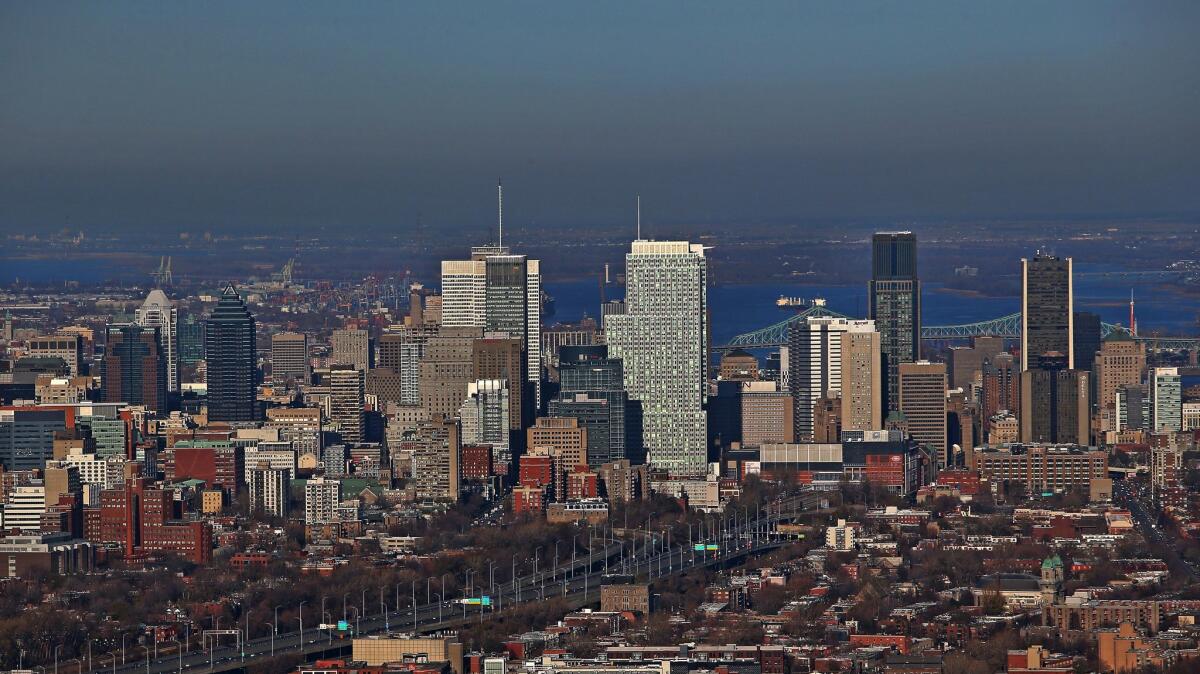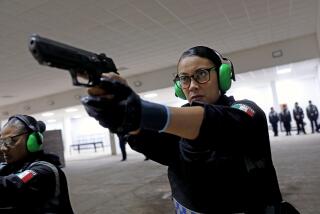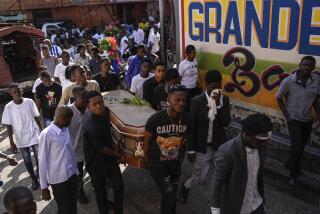Why Montreal has had only 19 homicides this year

Reporting from Montreal — There have been only 19 homicides in Montreal in 2016, and if the trend holds, the city will end up with fewer this year than any since the 1960s.
With a population of about 1.7 million, the Canadian city is slightly larger than Philadelphia and Phoenix. But Montreal saw only 28 homicides in 2014, compared with 248 and 114 in the two U.S. cities that year, respectively.
Montreal reported 1.4 homicides per 100,000 inhabitants that year, compared with 6.7 in Los Angeles.
It can be difficult to uncover exactly why, in cities of similar size, the homicide rate should differ so drastically. The availability of firearms, however, stands out as a stark difference, one that Etienne Blais, a University of Montreal professor who works with the International Center for Comparative Criminology, points to immediately.
There are almost four times as many firearms per capita in the U.S. as there are in Canada, their presence probably making violent altercations more deadly, Blais said.
Looking at other industrialized democracies, we do just horribly in terms of homicide.
— David Hemenway, professor of health policy at Harvard University
“If you look at murder attempts and other assaults [in Montreal], they’re going up a little bit,” he said. “One of the hypotheses is that there aren’t fewer homicidal situations, or situations that could end in homicide, but maybe the means are less lethal than before.”
A 2000 study co-written by David Hemenway, professor of health policy at Harvard University, found a strong correlation between gun availability and homicide rates.
According to Hemenway, the ease with which firearms can be acquired has tragic consequences in the U.S.
“Looking at other industrialized democracies, we do just horribly in terms of homicide,” he said. “We’re an average country in terms of all sorts of crimes — assault, sexual assault, robbery, burglary, car theft — but one thing we’re a complete outlier on is homicide. We’re particularly an outlier on gun homicide.”
Though guns in the U.S. are generally manufactured and sold legally, subsequent thefts, resales and transfers make tracking them, and their owners, nearly impossible. “Guns are readily available to virtually anyone who wants them,” Hemenway said. “A problem for countries like Canada is that they have the United States on their border. Most Canadian criminals who have guns get them from the United States.”
Montreal has also not seen the type of income-based segregation that characterizes many American cities. Even compared to other urban centers in Canada such as Toronto and Vancouver, Montreal has seen a far less pronounced, though steady, increase in such divisions.
Crime, particularly violent crime, tends to flourish in poor communities with few resources, something Montreal manages to avoid, Blais said.
“You don’t see that kind of tension where some people are left behind,” he said. “You get the impression that some communities are just not taken care of in the States.”
Hemenway agrees, suggesting a difference in how income and racial inequality interact in the two countries. “It’s class and race. If you discriminate against people and they have very few resources and they can’t get a good education, you’ve made it very hard to get a good job, you’ve made it very hard to live in better places. Not surprisingly you’ll have more street crime.”
“I’m not saying that we don’t have that here in Montreal,” Blais said, “but we’re light-years from what we see in the States.”
The presence of organized crime in Montreal, notably the prominent Hells Angels chapter and the Rizzuto family syndicate, may also — counterintuitively — act as a stabilizing presence.
“Montreal was once the murder capital of Canada. Montreal was also the auto theft capital of Canada, the robbery capital of Canada. Traditionally, Montreal was pretty hard, at least in the Canadian context,” said Carlo Morselli, director of the International Center for Comparative Criminology.
But the 2001 police crackdown on the Hells Angels may have changed things. Though those arrested during that time have been released, Blais said, “what they know is that if they go to war against other organizations, and there is collateral damage, they know that police forces are going to get organized.”
The incentive for those groups, then, is to keep tight control over Montreal’s criminal landscape, which Morselli believes might explain the low numbers of gang-related homicides. “If you have strong organized crime, you have a strong protection market,” and presumably a less precarious criminal situation, he said.
But as low as the city’s homicide rate may be, that provides little comfort to the families of those who are victims of violent crime.
In 2006, 17-year-old Brigitte Serre was one of 42 homicides in Montreal.
Brigitte was working the night shift at a Shell service station in Saint-Leonard, a borough in the north of Montreal, on Jan. 25 that year. It wasn’t her usual shift, but she had agreed to cover for a sick co-worker. Alone in the early hours of the morning, she couldn’t have known that across the street, two men were sitting in a bar, planning a robbery. One of them, 18-year-old Sebastien Simon, had been let go from the same job the day before. It had been Brigitte, who trained him and suspected him of stealing, who had reported him to the manager and gotten him fired.
Walking in with ski masks, the two men tied Brigitte up and locked her in the washroom before spending about an hour in the store, going so far as to put on uniforms and serve customers. Brigitte managed to free herself, but with no back exit through which to sneak out, she was trapped.
Simon, recognizing his former co-worker, beat Brigitte before stabbing her in the back 72 times. Two police officers, who had received calls about a seemingly empty service station, found her hours later, when Brigitte’s elder sister, who also worked there and was due to start the morning shift, let them into the store.
That morning, Brigitte’s father, Bruno Serre, was told of his daughter’s killing when he got to work.
“I told them that it wasn’t true, that they were wrong, that it was impossible,” he said in French. “You read about these things in the newspapers. You think it only happens elsewhere.”
It was a brutal killing, made all the more shocking by Montreal’s relatively low rate of deadly crimes.
Attempting to understand the underlying causes of homicide rates is a complex puzzle. And though a combination of many factors might explain Montreal’s low rate, for Serre, who now works for the Assn. of Families of Persons Assassinated or Disappeared, the statistics don’t make much difference.
“A murder’s a murder,” he says, a decade after Brigitte’s death. “Even one is too much. Every murder is too much.”
Favreau is a special correspondent.
ALSO
A spike in homicides. Job loss. Bad schools. Milwaukee unrest ‘isn’t about one thing’
10 shootings a day: Complex causes of Chicago’s spiking violence
The Los Angeles Times homicide report
More to Read
Sign up for Essential California
The most important California stories and recommendations in your inbox every morning.
You may occasionally receive promotional content from the Los Angeles Times.









